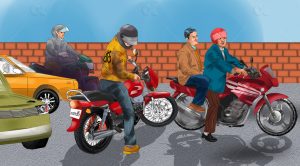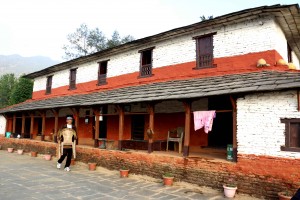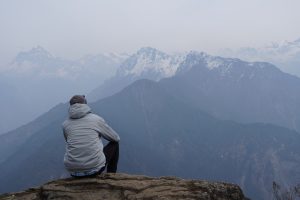
Photo: René Maya/Flickr
Setting out in the pre-dawn grayness, driving through a sleepy Kathmandu, my cousin and I were already filled with a sense of expectation. The roads that I was used to seeing choked with vehicles, horns blaring, was empty, its surface the same color as that of the sky.
My cousin, a photographer with a keen interest in wildlife, had wanted me to show him places around Kathmandu where he could photograph something wild. Shivapuri National Park had come to mind immediately—for reasons other than its faunal diversity and scenic beauty. Although I, too, wanted to see wild animals, a trip to Shivapuri would, if not anything else, be an escape from the city.
We parked at the entrance to the national park at Pani Muhan, and waited for it to get light. (Entering national parks before daybreak or after nightfall is prohibited.) Although there is a graveled road inside the park, we decided to leave our car at the entrance and walk from there. We reasoned that would increase our chances of spotting wild animals. After filling in our names and addresses in the visitors’ record book and paying the entry fee, we began walking, going past wooden boards with military aphorisms painted on them. We passed an abandoned army building, rounded a curve, and were in the wilderness.
Read also: In Nepal’s ancient salt hub Dana, a walk past yesterday
Feet scuttled in the brittle forest floor as we plodded up the road. There had been a bout of strong wind and rain the previous night. The signs of the storm were everywhere. Leaves covered the ground. Cutting a course through this leaf-littered floor were tiny gullies—remnants of the rivulets that had flowed the night before. The entire forest smelled and looked so fresh it seemed to have been created only a couple of hours ago.
We rounded a turn on the gravel road and came to a spot where there was a large gap in the screen of trees. Framed within this gap was Kathmandu, its notable landmarks – Singha Durbar, Swoyambhunath – faintly visible through the veil of smog that is almost a permanent feature of the Valley now. A little ahead the storm had knocked down a tree, blocking the road. We ducked under the branches and were able to pass. Emerging out of the canopy of trees, I saw a faint line of color amidst the dark tree tops on the hill in the distance. It was the prayer flags of the Nagi Gompa, our destination.

Photos: (Left) René Maya/Flickr (Right) Author, (Inset) Author.
When we arrived at the prayer hall of the monastery, a few people were busy sweeping the leaves strewn on the lawn. Some were collecting the leaves with their bare hands and throwing it into a doko, or wicker basket. When the basket was full, someone would carry it to the compost pit. In this group of cleaners was a blonde girl in a white dress and a man dressed exactly like Jesus in popular paintings. The only difference was that he had dreadlocks.
Both these almost anachronistic figures were busy sweeping, collecting, and dumping the leaves. They were helped by a couple of other people, who looked like they were the regular staff at the monastery.
***
Drums thudded and cymbals clanged. The chanting of Tibetan mantras, coming from nuns, was soft and sweet in contrast to the guttural and somber tone of recitals by monks.
The cleaning continued, as though it were a ritual.
I set my backpack on a bench and began collecting leaves and putting them in the doko. The guy with the dreadlocks gave me a smile and a nod of acknowledgment as we passed each other on our way to the dumping site. The blonde girl brought handfuls of leaves to put into my basket.
I moved from one section of the lawn to another. In one corner, under a corrugated iron roof, a few old nuns sat making butter lamps, gently nodding in greeting and flashing toothless smiles.
After some time, a maroon wave of nuns flowed out of the prayer hall. The dozens of pairs of flip-flops disappeared from the temple’s doorsteps. The nuns were mostly teenagers, some of them children of ten or less. A few were coy and silent. Others were mischievous and playful: the energy they had contained and channeled on the scriptures during prayers was now pouring out in nudges, bantering, and laughter. They joked with my cousin as he walked by, struck poses for him when he trained his camera on them, trying hard to put on calm expressions but bursting out in giggles within seconds. They pursed their lips and suppressed their mirth instantaneously when an old nun trudged by, turning over her prayer beads.

It was a lovely day and an equally beautiful setting. I drank the sweet water that flows unceasingly from the several taps at the monastery. Rice bowls laid out in rows to dry in the sun reminded me that I was in a monastic community, where people helped each other in their spiritual aspirations. I felt a sense of irony when I thought how lay men and women had worked together to clean a garden, demonstrating, if only for the moment, the beauty of society, and doing it in a place removed, at least physically, from society.
I set aside an hour or more each day to be alone, and to be alone in a place that allows me to do something (mostly by not doing much) with that priceless solitude. I go away from Kathmandu once in a while, for a day or two, sometimes for longer. The logic is that such excursions will allow me to clear my mind and reinvigorate myself. It is basically turning my back on Kathmandu.
Walking back toward our car that morning, through a green tunnel of arching trees that were abuzz with bird song, I reflected on the morning I had just had. There were no photos of wild animals in our cameras. Even the ubiquitous eagles that wheel and dip near the monastery had been surprisingly absent. My mind kept going back to the team of strangers, some whose job it was to keep the monastery premises clean, others who had helped them because they happened to be there. I felt a sense of satisfaction. It was partly because of the rejuvenating place I had been in and partly because of the experience of the day. But it was mostly due to the realisation that I was returning not to a changed city but with a change in my way of looking at it. ■
























